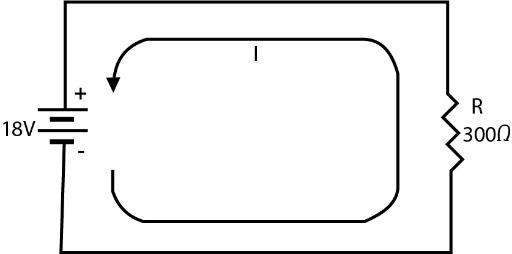
If the voltage in the given circuit was cut in half, what would the current equal?

A) 20mA
B) 60mA
C) 30mA
D) 18mA

Answer
557.7k+ views
Hint
As in the question it is given that the voltage is cut in half so the new voltage will be $V' = \dfrac{V}{2}$, V is the given voltage. Now in order to find out the current we will apply the ohm’s law i.e. $V' = IR$, by substituting the given values we will get the desired value of current.
Complete step by step answer
As, from the circuit diagram it is given that
The applied voltage is $V = 18V$
And the resistance of the given circuit is $R = 300\Omega $
Now, it is also given that the voltage in the given circuit was cut in half, we have to find out the value of current.
Therefore, the new voltage is $V' = \dfrac{V}{2}$
On substituting the value of given applied, we get
$V' = \dfrac{{18}}{2} = 9V$ …………………… (1)
Now, we will apply the ohm’s law which states that voltage is equal to the product of the current and the resistance i.e. $V' = IR$ ………………………. (2)
Where, I is the current passing through the circuit when the voltage is cut to half
R is the resistance applied across the circuit.
Now, substitute the value of new voltage and resistance in above equation, we get
$\Rightarrow 9 = I \times 300$
$\Rightarrow I = \dfrac{9}{{300}} = \dfrac{3}{{100}}A $
As, we also know that $1A = {10^{ - 3}}mA$
Therefore, the required value of current is
$ \Rightarrow I = \dfrac{{30}}{{1000}} = 30 \times {10^{ - 3}}A = 30mA$
Hence, if the voltage is cut in half in the given circuit then the value of current is 30mA.
Therefore, option (C) is correct.
Note It must be notice that for these types of questions, where the voltage and resistance is given and we have to find out the value of current, or in the question where there is any relation is given between current, voltage and resistance then we always use the ohm's law i.e., here R is the total resistance of the circuit. As here in the above question only one resistance is given so total resistance is the same as that of the given resistance. But in some cases, we have given more than one resistance for that we will see whether resistances are in series or in parallel combination then by using the suitable formula, we can use the suitable value of the resistance. After that by substituting the given values in the ohm's law, we get the desired result.
As in the question it is given that the voltage is cut in half so the new voltage will be $V' = \dfrac{V}{2}$, V is the given voltage. Now in order to find out the current we will apply the ohm’s law i.e. $V' = IR$, by substituting the given values we will get the desired value of current.
Complete step by step answer
As, from the circuit diagram it is given that
The applied voltage is $V = 18V$
And the resistance of the given circuit is $R = 300\Omega $
Now, it is also given that the voltage in the given circuit was cut in half, we have to find out the value of current.
Therefore, the new voltage is $V' = \dfrac{V}{2}$
On substituting the value of given applied, we get
$V' = \dfrac{{18}}{2} = 9V$ …………………… (1)
Now, we will apply the ohm’s law which states that voltage is equal to the product of the current and the resistance i.e. $V' = IR$ ………………………. (2)
Where, I is the current passing through the circuit when the voltage is cut to half
R is the resistance applied across the circuit.
Now, substitute the value of new voltage and resistance in above equation, we get
$\Rightarrow 9 = I \times 300$
$\Rightarrow I = \dfrac{9}{{300}} = \dfrac{3}{{100}}A $
As, we also know that $1A = {10^{ - 3}}mA$
Therefore, the required value of current is
$ \Rightarrow I = \dfrac{{30}}{{1000}} = 30 \times {10^{ - 3}}A = 30mA$
Hence, if the voltage is cut in half in the given circuit then the value of current is 30mA.
Therefore, option (C) is correct.
Note It must be notice that for these types of questions, where the voltage and resistance is given and we have to find out the value of current, or in the question where there is any relation is given between current, voltage and resistance then we always use the ohm's law i.e., here R is the total resistance of the circuit. As here in the above question only one resistance is given so total resistance is the same as that of the given resistance. But in some cases, we have given more than one resistance for that we will see whether resistances are in series or in parallel combination then by using the suitable formula, we can use the suitable value of the resistance. After that by substituting the given values in the ohm's law, we get the desired result.
Recently Updated Pages
Master Class 12 Economics: Engaging Questions & Answers for Success

Master Class 12 Maths: Engaging Questions & Answers for Success

Master Class 12 Biology: Engaging Questions & Answers for Success

Master Class 12 Physics: Engaging Questions & Answers for Success

Basicity of sulphurous acid and sulphuric acid are

Master Class 12 Business Studies: Engaging Questions & Answers for Success

Trending doubts
What are the major means of transport Explain each class 12 social science CBSE

Which are the Top 10 Largest Countries of the World?

Draw a labelled sketch of the human eye class 12 physics CBSE

How much time does it take to bleed after eating p class 12 biology CBSE

Explain sex determination in humans with line diag class 12 biology CBSE

Differentiate between homogeneous and heterogeneous class 12 chemistry CBSE




